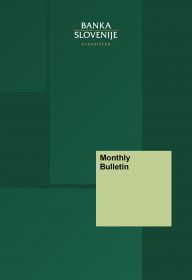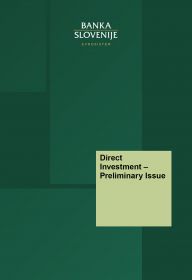
Statistics
Our statistics provide data support for decisions on monetary policy, financial stability, banking supervision, and broader economic policy. Financial statistics data help financial institutions, businesses, and the public in making informed decisions.
We collect, organise, and publish macroeconomic statistics of financial institutions and markets, external statistics, financial accounts, and data for the banking supervision.
We are committed to ensuring the highest standards of quality and confidentiality in the data that we manage independently. We are part of the European System of Central Banks (ESCB), where the highest data management standards apply (Public Commitment on European Statistics). Under the National Statistics Act, we are an authorised provider of statistical surveys, making us an integral part of the Annual Programme of Statistical Surveys of the Republic of Slovenia.
Highlighted
Upcoming
The release calendar of the Financial Statistics Department covers the releases of statistics on the Data series portal, and on the Statistics website under the Data sections. On the publication date, the data is published no later than 11 am.
External statistics | Financial institutions and markets | Financial accounts | |||
07. October | International reserves and foreign currency liquidity, September 2025 | 01. October | Monetary financial institutions interest rate statistics | 15. October | Quarterly financial accounts |
14. October | Balance of payments Gross external debt Travel (only in Slovene) August 2025 International reserves and foreign currency liquidity | 27. October | Balance sheet and detailed data of the Monetary financiral institutions | ||
Publications

International services trade by enterprise characteristics in 2024
Featured
Climate change-related indicators of the European System of Central Banks (ESCB)
As part of the ESCB, in 2021 we began developing harmonized climate change-related indicators to assess the impact of climate change on financial stability and the monetary policy of the Eurosystem. These indicators are divided into three groups:
• sustainable finance indicators: track trends in the financing of green and other sustainable projects;
• carbon emission indicators: monitor progress in reducing emissions;
• physical risk indicators: measure the consequences of climate change.
Note: The ESCB climate change-related indicators are still under development. The sustainable finance indicators are classified as experimental statistical indicators, as they mostly meet the official ECB requirements for statistical quality. The emission and physical risk indicators are classified as analytical, as the methodology for their calculation is still being developed. Therefore, there may be significant discrepancies between different data releases.
A brief overview, presentation and links to the data are provided in the tabs below.
Sustainable finance indicators show the issuance and holding of green, social and sustainable debt securities by residents in the euro area. These indicators are available on a monthly basis (issuances) or quarterly basis (holdings), starting from December 2020 or the first quarter of 2021. They can be accessed via the link.
Issuances of sustainable debt securities in the euro area
The outstanding amount of sustainable debt securities issued in the euro area has more than tripled in the last three years. However, their share remains relatively small, accounting for less than 7% of all debt securities issued in the euro area. Among these, green debt securities dominate, making up two-thirds of the market.
Source: ESCB calculations.
Holdings of sustainable debt securities in the euro area
Euro area holdings of sustainable debt securities have increased significantly in the last three years. Nevertheless, they still represent only 7% of the total debt securities portfolio of the euro area.
Source: ESCB calculations.
Issuances and holdings of green debt securities by country
The largest issuers and holders of green debt securities in the euro area are Germany and France, which together represent approximately half of the market in these instruments. The third-largest issuer is the Netherlands, while Luxembourg is the third-largest holder. Other countries, including Slovenia, represent a relatively small share of both green bond issuances and holdings.
Source: ESCB calculations.
Carbon emission indicators are divided into two groups:
• the first group shows the emissions (direct and indirect) of companies financed by financial institutions (through the issuance of loans or the purchase of their securities);
• the second group shows the exposure of the financial sector's portfolio to carbon-intensive activities.
The first group includes the indicators of financed emissions (FE) and carbon intensity (CI), while the second group includes the weighted average carbon intensity (WACI) and carbon footprint (CFP).
The indicators are based on emissions from Scope 1 and 2 (with the exception of the indicators for bank loans, which are only available for Scope 1 emissions):
• Scope 1 emissions are all direct emissions from sources owned or directly controlled by the company. This includes emissions from the combustion of fuels in boilers, furnaces, vehicles and other equipment, as well as fugitive emissions from industrial processes.
• Scope 2 emissions are indirect emissions that occur from the generation of purchased electricity, heat, or steam consumed by the company. These emissions occur at the energy producer but are a result of the energy consumption by the company.
The indicators refer to the global or total emissions of the company, meaning those generated by the entire group of affiliated companies. On the other hand, the indicators for loans are further broken down into local or national levels, displaying the emissions of individual companies at the local or national level. The data is annual and available from 2018 onwards.
Carbon emissions indicators on loans from Slovenian banks
According to the financed emissions (FE) indicator, local direct emissions of companies financed through loans issued by Slovenian banks, similar to the euro area, decreased between 2018 and 2021. Similarly, the exposure of banks' loan portfolios to transition risks also declined during the same period. This is reflected in the carbon intensity indicator (WACI), which fell below pre-crisis levels in 2021.
Source: ESCB calculations.
Note: The indicators refer to local (data at the level of individual entities is considered) Scope 1 emissions (those that originate from owned or controlled sources).
Carbon emissions indicators on securities portfolios of Slovenian banks
Global (direct and indirect) emissions of companies financed by banks through the purchase of their securities are also considerably lower than before the pandemic, despite the increase in 2021. Similarly, the exposure of the banks' securities portfolio is lower.
Source: ESCB calculations.
Note: The indicators refer to global emissions (consolidated data at the level of a group of affiliated companies is considered). Securities include listed shares and debt securities.
Breakdown of annual changes in weighted average carbon intensity (WACI) of Slovenian banks’ loan portfolios
The chart shows the breakdown of the annual changes in the carbon intensity indicator (WACI) into the company emissions and their revenues, as well as the reallocation of the banking portfolio.
The indicator for bank loans worsened (increased) in the pandemic year 2020, as the decline in company revenues was more pronounced compared to their emissions. However, by 2021, it dropped below pre-crisis levels (improved), mainly due to the recovery of company operations as restrictions were lifted.
Source: ESCB calculations.
Note: The indicator refers to local Scope 1 emissions. A lower WACI value can result from a reduction in company emissions, an increase in their revenues (which appear in the denominator), or the reallocation of the bank's portfolio towards greener investments.
Breakdown of annual changes in weighted average carbon intensity (WACI) of Slovenian banks’ securities portfolios
After improving (decreasing) in 2019, mainly due to the reallocation of the bank portfolio towards greener investments, the indicator for the banks’ securities portfolio remained roughly unchanged in 2020, as company revenues decreased by about the same amount as their emissions. In 2021, it slightly worsened (increased), but remained significantly below pre-crisis levels.
Source: ESCB calculations.
Note: The indicator refers to global Scope 1 emissions. Securities include listed shares and debt securities. A lower WACI value can result from a reduction in company emissions, an increase in their revenues (which appear in the denominator), or the reallocation of the bank's portfolio towards greener investments.
Physical risk indicators are divided into two groups:
the first group shows the financial system exposures to companies located in areas susceptible to natural disasters,
the second group measures the expected losses in the portfolios of financial institutions correlated to the inability to repay debts due to natural disasters.
The first group includes potential exposure at risk (PEAR) and physical risk scores (RS), while the second group includes normalized exposure at risk (NEAR) and collateral-adjusted exposure at risk (CEAR).
The indicators are calculated based on historical data and for two different scenarios – the RCP 4.5 and the more stringent RCP 8.5 – which allow for the analysis of climate change risks under different levels and concentrations of emissions in the atmosphere. They are based on the Fifth Assessment Report of the Intergovernmental Panel on Climate Change (IPCC AR5). The indicators are available for the following hazards: coastal and river flooding, windstorms, landslides, subsidence, wildfires and water stress.
Methodology Data
The RCP 4.5 and RCP 8.5 scenarios are used by the IPCC to model future climate changes.
Portfolio exposures of euro area financial institutions to different hazards
According to the physical risk score (RS) indicator, the portfolios of financial institutions in the euro area are exposed to low to medium risks. However, hazards related to temperature and rainfall present a greater risk to these portfolios, especially under the pessimistic RCP 8.5 scenario.
LS denotes landslides, SB subsidence and WS windstorms.
Source: ESCB calculations.
Note: Financial institutions include deposit-taking corporations except central banks (S122), non-money market fund investment funds (S124), insurance corporations (S128) and pension funds (S129). All instruments are included, namely debt securities, equities and loans. The indicators (RS and PEAR) are not comparable across different hazards. CDD denotes the consecutive number of dry days, while SPI stands for the standardized precipitation index. Indicators for certain hazards (landslides, subsidence, windstorms) are calculated only based on historical data. The shown RCP 8.5 scenario refers to the year 2050.
Potential exposure at risk with and without flood protection
The chart shows the financial exposure of countries to companies located in flood-prone areas and illustrates the effectiveness of flood protection measures (under the RCP 8.5 scenario).
Flood protection standards in coastal areas are generally more effective than those for river flooding, in both cases significantly reducing flood risk and, consequently, the financial exposure of individual countries.
Among the countries most exposed to river flooding, the highest risk reduction is observed in the Netherlands (by 16.1%), Austria (by 8.4%), Italy (by 5.3%) and Germany (by 4.6%) when accounting for flood defences. The financial exposure of the Netherlands to companies located in coastal areas is also significantly lower (by more than 90%), which, according to the PEAR indicator (considering the impact of flood defences), places the Netherlands in third place, just behind Germany and Finland.
Due to flood protection measures, Slovenia’s exposure is also reduced, by 2.6% (river flooding) and 41.5% (coastal flooding), positioning Slovenia roughly in the middle of the EU member states' rankings.
Source: ESCB calculations.
Note: Financial institutions include deposit-taking corporations except central banks (S122), non-money market fund investment funds (S124), insurance corporations (S128) and pension funds (S129). All instruments are included, namely debt securities, equities and loans. The shown RCP 8.5 scenario refers to the year 2050. The countries are ranked by the PEAR indicator value.
Expected losses on euro area banks' loan portfolios
According to the normalized exposure at risk (NEAR) indicator, the largest expected losses in the euro area are related to river flooding (amounting to 1% of the loan portfolio). In the case of coastal flooding and windstorms, the losses are lower (0.4% and 0.1% of the portfolio, respectively). When considering collateral, the expected losses are significantly reduced: in the case of river flooding, by three-fifths, and for coastal flooding and windstorms, by approximately 80% (based on the CEAR indicator).
Source: ESCB calculations.
Note: The indicators (NEAR and CEAR) are available only for banks' loan portfolios. The shown RCP 8.5 scenario refers to the year 2050.
Related topics


